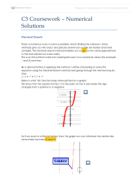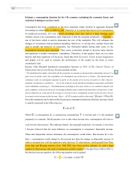Estimate a consumption function for the UK economy explaining the statistical techniques you have used.
Project: Estimate a consumption function for the UK economy explaining the statistical techniques you have used. Abstract The purpose of doing this project is to estimate different consumption functions and to observe the relationships between consumption and a set of variables, such as household disposable income, house price inflation and inflation. I have extended my data to include the periods 1999 to 2001. I will construct and apply a model to such data and apply an appropriate set of tests to it. This project will be achieved using PC GIVE, which is a computerised statistical package. This will enable me to produce graphical analysis and present results in an appropriate manner. Introduction To address economic problem in context we separate an economy's aggregate expenditure (Y) into four categories: consumption (C), investment (I), government expenditure (G), and net foreign expenditure, or exports less imports (X-M). The aggregate demand identity Y=C + I + G + (X - M) Is used to represent these four elements. It is useful to make this kind of categorization, because different agents are responsible for each type of expenditure and therefore they must have different determinants. (William E.Griffiths, R, Carer Hill, George G. Judge, (1993) Learning and Practicing Econometrics, 1993 by John Wiley & Sons, Inc, page 261) Consumption is the most important
Pure 2 coursework - Decimal Search Method
Pure 2 coursework Decimal Search Method In order to find the root of the function f(x)=3x3-7x2-11x+17, the decimal search method was used. This is the process whereby a table of values is constructed that show whether the value of f(x) with certain values of x is positive or negative. By zooming in on the places where the value of f(x) switches from positive to negative (or vice versa), values for the root of this function can be found. x f(x) -4 -243 -3 -94 -2 -13 -1 8 0 7 2 2 -9 3 2 4 53 5 62 From this table, it is clear that there are roots where f(x)=0 when values of x lie between -2 and -1, 1 and 2, and 2 and 3. By concentrating on the interval of [1,2], the rot can be found to a greater level of accuracy. x f(x) 2 .1 0.423 .2 -1.096 .3 -2.539 .4 -3.888 .5 -5.125 .6 -6.232 .7 -7.191 .8 -7.984 .9 -8.593 2 -9 It is now clear that the root lies somewhere inside the interval of [1.1, 1.2] x f(x) .1 0.423 .11 0.268193 .12 0.113984 .13 -0.03961 .14 -0.19257 .15 -0.34488 .16 -0.49651 .17 -0.64746 .18 -0.7977 .19 -0.94722 .2 -1.096 The root is in the interval [1.12, 1.13] x f(x) .12 0.113984 .121 0.098597 .122 0.083216 .123 0.067841 .124 0.052472 .125 0.037109 .126 0.021753 .127 0.006403 .128 -0.00894 .129 -0.02428 .13 -0.03961 The root is somewhere inside the interval [1.127,
The method I am going to use to solve x−3x-1=0 is the Change Of Sign Method involving the Decimal Search method
Mathematics C3 Coursework Numerical solutions of equations Decimal Search Method --------------------------------------------p.1 Rearrangement Method ------------------------------------------- p.5 Newton-Raphson Method ----------------------------------------- p.9 Comparison ----------------------------------------------------------- p.12 Solving x³-3x-1=0 using the "Change Of Sign" Method: The method I am going to use to solve x³-3x-1=0 is the Change Of Sign Method involving the Decimal Search method, which is that you are looking for the roots of the equations f(x)=0. This means that I want the value of x for which the graph of y=f(x) crosses the x axis. As the curve crosses the x axis, f(x)changes sign, so provided that f(x) is continuous function, once I have located an interval in which f(x) changes sign, I know that that interval must contain a root. Now, I have drawn the graph of x³-3x-1=0 by using the Autograph software, and the graph is shown below: The point that the arrow pointing is the root I need to find. From my graph above, I can see that the root of the equation is between x=0 and x=-1. The table of x values and f(x) values is shown below. I can work out the f(x) values by substituting the x-values into the equation. x f(x) -0.1 -1.299 -0.2 -0.408 -0.3 -0.127
In this coursework I will be looking at equations that cannot be solved algebraically
Core 3 Coursework In this coursework I will be looking at equations that cannot be solved algebraically. Instead I will look at three numerical methods for solving them: the change of sign method; the Newton-Rhapson method; and the rearranging method. Change of Sign Method - Decimal Search I am going to solve the equation using the decimal search (change of sign) method. I will find the y-values and look for the point at which there is a change of sign, because if there is a change from positive y to negative y then the curve must pass through the x-axis so there will be a root. Here is a graph of the function There is only one root; it lies between the integer bounds [-1,0] I have calculated the corresponding y-value for each x-value within this range, 1 decimal place apart. x y -1.0 -5 -0.9 -3.635 -0.8 -2.52 -0.7 -1.625 -0.6 -0.92 -0.5 -0.375 -0.4 0.04 -0.3 0.355 -0.2 0.6 -0.1 0.805 x y -0.50 -0.375 -0.49 -0.3281 -0.48 -0.2826 -0.47 -0.2382 -0.46 -0.1951 -0.45 -0.1531 -0.44 -0.1123 -0.43 -0.07263 -0.42 -0.03404 -0.41 0.003495 -0.40 0.04 Again the change of sign is highlighted; the root must lie between [-0.42,-0.41], so I will investigate these values. x y -0.420 -0.03404 -0.419 -0.03024 -0.418 -0.02645 -0.417 -0.02267 -0.416 -0.0189 -0.415 -0.01514 -0.414 -0.01139 -0.413 -0.007656 -0.412 -0.003929
Change of Sign Method
Change of Sign Method To look at how this method I will find the roots of the equation x5-7x+5=0 by the change of sign method. Here is a graph of y=x5-7x+5 and an integer search showing where the roots of x5-7x+5=0: x -5 -4 -3 -2 -1 0 2 3 4 5 y -3085 -991 -217 -13 1 5 -1 23 227 001 3095 This equation has 3 roots as shown in the table as the y value changes sign 3 times in the table, one between x=-2 and x=-1 another between x=0 and x=1 and another between x=1 and x=2. This is also shown in the graph. A root can be more accurately found using a decimal search or zooming in on a graph and identifying when a change of sign occurs. I will do this to find the root of this equation between x=-2 and x=-1: x -2 -1.9 -1.8 -1.7 y -13 -6.461 -1.2957 2.7014 As there is a change in sign between x=-1.8 and x=-1.7 there must be a root between x=-1.8 and x=-1.7 as shown on the graph above. Therefore a decimal search to two decimal places will be more accurate. x -1.8 -1.79 -1.78 -1.77 y -1.2957 -0.8466 -0.409 0.0173 Therefore there is a root between x=-1.78 and x=-1.77 which can be more accurately found. x -1.78 -1.779 -1.778 -1.777 -1.776 -1.775 -1.774 -1.773 -1.772 -1.771 -1.77 y -0.409 -0.3659 -0.3228 -0.2799 -0.2371 -0.1944 -0.1519 -0.1094 -0.067 -0.0248 0.0173 Therefore there is a root between x=-1.771 and x=-1.770
C3 Coursework: Numerical Methods
C3 Coursework: Sapphire Mason-Brown C3 Coursework Numerical Methods The place in which the graph of a line crosses the x axis is known as the root of the equation. It is not always possible to find the solution of an equation by algebraic or analytical methods such as factorising. This applies to equations such as y=3x3-11x+7. To solve equations such as these, numerical methods such as change of sign, x=g(x) and Newton-Raphson can be used to give estimates of the roots. Change of Sign Method The Change of sign method is a method used to look for when a sequence of numbers in the boundary of a root change from negative the positive or vice versa. This change means that the root of the equation is somewhere between the interval where there is a change of sign. This is the graph of the equation y=3x3-11x+7 There are 3 roots to the equation y=3x3-11x+7, this is illustrated by the three intersections with the x axis. There appears to be a root between 0 and 1. By taking increments of 0.1 between 0 and 1 it will be possible to use decimal search to look for a change in sign. This will make it possible to find an approximation for to the root between 0 and 1. This table shows the results of the numbers in increments of 0.1 between 0 and 1. Upon looking at the results we can see that there is a change of sign between 0.7 and 0.8, this shown by the graph below. This method
Solution of equations by numerical methods.
PURE MAHEMATICS 2 COURSEWORK SOLUTION OF EQUATIONS BY NUMRICAL METHODS . Change of sign Method * Decimal Search * Chosen Equation: Y = 2X3 - 5X -2 There are three possible roots for this equation as its graph crosses the x-axis three times. By looking at the graph it is possible to estimate the where about of the roots. Furthermore by testing for the existence of change of sign between any two chosen points I could be able to decide if there is a root or not. Looking at the graph of any equation is also vital as there might be some discontinuities. I will be testing if there is a root between points [-1,0]. i. For [-1,0] - Substituting this two points in the equation Y = 2X3 - 5X-2 gives: x -1 0 y -2 As it can be seen there is a change of sign, which implies that there is a root between the two points. To find this point to a limited degree of accuracy I will be using decimal search, whose working out is shown below. x 0 -0.1 -0.2 -0.3 -0.4 -0.5 -0.6 -0.7 -0.8 -0.9 -1 y -2 -1.502 -1.016 -0.554 -0.128 0.25 0.568 0.814 0.976 .042 x -0.4 -0.41 -0.42 -0.43 -0.44 -0.45 -0.46 -0.47 -0.48 -0.49 -0.5 y -0.12800 -0.08784 -0.04818 -0.0090 0.029632 0.067750 0.105328 0.142354 0.178816 0.21470 0.25000 x -0.43 -0.431 -0.432 -0.433 -0.434 -0.435 -0.436 -0.437 -0.438 -0.439 -0.44 y -0.009 -0.00513 -0.0012 0.0026
Three ways of reading The Bloody Chamber.
Three ways of reading The Bloody Chamber In order to look at The Bloody Chamber as a set of interlinked stories which can be read in a variety of ways, I propose to use the ideas about language and myth as semiological systems that Barthes expounds in Mythologies. A brief account of Barthes views is therefore necessary. Barthes, following Saussure, looks upon a story as comprising a semiological structure, with three terms - signifier, signified and sign. The signifier is the linguistic unit: word, sentence, story. The signified is the thing the signifier refers to, object, thought, concept. The sign is the unity that the signified and signifier constitute for us. Barthes gives the example of someone giving a bunch of roses as a token of their affection to someone. The roses are the signifier, the signified is their passion, and the sign is the unity of signifier and signified, 'passionified' roses, which we grasp in thought. For Barthes, myth as a semiological system constitutes a second order semiological system. That is, in a myth, the signifier, the first tem in the semiology of myth, is already an item which is full of meaning, a sign. The following diagram should help to clarify Barthes point. signifier signified sign SIGNIFIER SIGNIFIED SIGN Here, the first order terms are given in lower case: signifier, signified and sign, and the second order, mythic,
Solutions of Equations by Numerical Methods - Change of sign Method and Decimal Search Method.
Solutions of Equations by Numerical Methods Change of sign Method Decimal Search Method f(x)=x³+2x²-3x+2 The solutions of f(x)=0 are the place where the curve cuts the x-axis. The graph shows that there is one real root lying in the interval [-4,-3] f(-4) = -64+32+12+2 = -18 f(-3 )= -27+18+9+2 = 2 The function f(x) is continuous therefore the change of sign form negative to positive in moving from x=-4 to x=-3 shows that there must be a root between the two values. The decimal search method will locate more accurate values of the root systematically by taking increments of size 0.1 in the interval [-4,-3] until a change of sign occurs. x -4 -3.9 -3.8 -3.7 -3.6 -3.5 -3.4 -3.3 -3.2 -3.1 -3 f(x) -18.000 -15.199 -12.592 -10.173 -7.936 -5.875 -3.984 -2.257 -0.688 0.729 2.000 There is a change of sign between -3.2 and -3.1, this show that the root is in the interval [-3.2,-3.1] Continuing the decimal search method will increase the accuracy by narrowing down the interval further. x -3.20 -3.19 -3.18 -3.17 -3.16 -3.15 -3.14 -3.13 -3.12 -3.11 -3.10 f(x) -0.688 -0.540 -0.393 -0.247 -0.103 0.039 0.180 0.320 0.457 0.594 0.729 x -3.16 -3.159 -3.158 -3.157 -3.156 -3.155 -3.154 -3.153 -3.152 -3.151 -3.15 f(x) -0.103 -0.089 -0.075 -0.060 -0.046 -0.032 -0.018 -0.003 0.011 0.025 0.039 x -3.153 -3.1529
Investigate the three different numerical methods used to solve equations.
Solving Equations by Numerical Methods Introduction In this coursework I am going to investigate the three different numerical methods used to solve equations. These include the change of sign method, Newton Raphson method and the Rearranging method. To carry out the investigation I will explain how each method works, using an example of a working equation in each case. I will also show when each of the methods will not work with other equations. I will then compare all three of the methods. Change of sign method Decimal search and Interval bisection are both ways of finding an interval where there is a change of sign. The change of sign can be found on a graph when the line crosses the x-axis. Wherever there is a change of sign there will be a root. These two methods find the interval where the root lies. Decimal Search To find the roots using decimal search, the y-values must be found, using the values of X from 0.1, 0.2, 0.3, all the way up to 1. When a change of sign occurs, this means there is a root lying here. Once the root interval to 1 decimal place has been found, it must then be found to 2 and 3 decimal places and so on to the required number of places. Y=x3-5x+1 can be solved using decimal search. The table shows that the routes can be found. X Y X Y X Y 0 2 -1 -2 3 0.1 0.501 2.1 -0.239 -2.1 2.239 0.2 0.008 2.2 0.648 -2.2 .352 0.3















